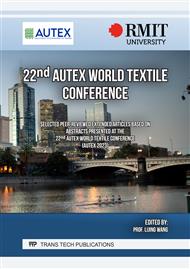[1]
Angelucci, A.; Cavicchioli, M.; Cintorrino, I. A.; Lauricella, G.; Rossi, C.; Strati, S.; Aliverti, A.: Smart Textiles and Sensorized Garments for Physiological Monitoring: A Review of Available Solutions and Techniques. Sensors (Basel, Switzerland) 21(2021)3
DOI: 10.3390/s21030814
Google Scholar
[2]
Ismar, E.; Kurşun Bahadir, S.; Kalaoglu, F.; Koncar, V.: Futuristic Clothes: Electronic Textiles and Wearable Technologies. Global challenges (Hoboken, NJ) 4(2020)7, S. 1900092.
DOI: 10.1002/gch2.201900092
Google Scholar
[3]
Anita Vogl; Patrick Parzer; Teo Babic; Joanne Leong; Alex Olwal; Michael Haller: StretchEBand: Enabling Fabric-Based Interactions through Rapid Fabrication of Textile Stretch Sensors. 2017.
DOI: 10.1145/3025453.3025938
Google Scholar
[4]
Islam, G. M. Nazmul; Collie, S.; Qasim, M.; Ali, M. Azam: Highly Stretchable and Flexible Melt Spun Thermoplastic Conductive Yarns for Smart Textiles. Nanomaterials (Basel, Switzerland) 10(2020)12
DOI: 10.3390/nano10122324
Google Scholar
[5]
Onggar, T.; Kruppke, I.; Cherif, C.: Techniques and Processes for the Realization of Electrically Conducting Textile Materials from Intrinsically Conducting Polymers and Their Application Potential. Polymers 12(2020)12
DOI: 10.3390/polym12122867
Google Scholar
[6]
Kim, I.; Shahariar, H.; Ingram, W. F.; Zhou, Y.; Jur, J. S.: Inkjet Process for Conductive Patterning on Textiles: Maintaining Inherent Stretchability and Breathability in Knit Structures. Advanced Functional Materials 29(2019)7, S. 1807573.
DOI: 10.1002/adfm.201807573
Google Scholar
[7]
Gaubert, V.; Gidik, H.; Bodart, N.; Koncar, V.: Investigating the Impact of Washing Cycles on Silver-Plated Textile Electrodes: A Complete Study. Sensors (Basel, Switzerland) 20(2020)6
DOI: 10.3390/s20061739
Google Scholar
[8]
Wieczorek, F.; Winger, H.; Böhnke, P. Ruth Christine; Wagner, J.; Häntzsche, E.; Nocke, A.; Kruppke, I.; Cherif, C.: Novel Knitting Vision - Modern Ways for Integral Knitting of Intelligent Gloves for Tactile Internet Applications. Solid State Phenomena 333(2022), S. 39–46.
DOI: 10.4028/p-5zh70u
Google Scholar
[9]
Ismar, E.; Zaman, S. uz; Tao, X.; Cochrane, C.; Koncar, V.: Effect of Water and Chemical Stresses on the Silver Coated Polyamide Yarns. Fibers and Polymers 20(2019)12, S. 2604–2610.
DOI: 10.1007/s12221-019-9266-4
Google Scholar
[10]
Baribina, N.; Baltina, I.; Oks, A.: Application of Additional Coating for Conductive Yarns Protection against Washing. Key Engineering Materials 762(2018), S. 396–401.
DOI: 10.4028/www.scientific.net/kem.762.396
Google Scholar
[11]
Alagirusamy, R.; Eichhoff, J.; Gries, T.; Jockenhoevel, S.: Coating of conductive yarns for electro-textile applications. Journal of the Textile Institute 104(2013)3, S. 270–277.
DOI: 10.1080/00405000.2012.719295
Google Scholar
[12]
A . Raja, G. Thilagavathi, Kannaian T.: Synthesis of spray dried polyvinyl pyrrolidone coated silver nanopowder and its application on wool and cotton for microbial resistance. Indian Journal of Fibre & Textile Resear 35(2010)1, S. 59–64.
Google Scholar
[13]
Böhnke, P. Ruth Christine; Winger, H.; Wieczorek, F.; Warncke, M.; Lüneburg, L. Marie; Kruppke, I.; Nocke, A.; Häntzsche, E.; Cherif, C.: Protective Coating for Electrically Conductive Yarns for the Implementation in Smart Textiles. Solid State Phenomena 333(2022), S. 11–20.
DOI: 10.4028/p-9q3n92
Google Scholar
[14]
Norm 16812 2016. Textilien und textile Erzeugnisse- Elektrisch leitfähige Textilien – Bestimmung des linearen elektrischen Widerstands von Leiterbahnen.
DOI: 10.31030/2358969
Google Scholar
[15]
Warncke, M.; Böhnke, P.; Gracova, A.; Nocke, A.; Cherif, C.: Development of test method for the characterization of electrically conductive yarns for integration in smart textiles: Łódź University of Technology Press, 2022.
Google Scholar



